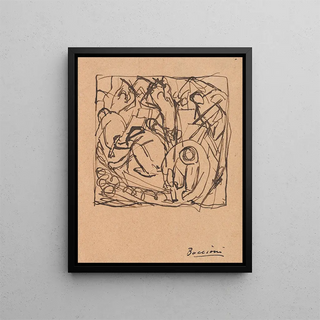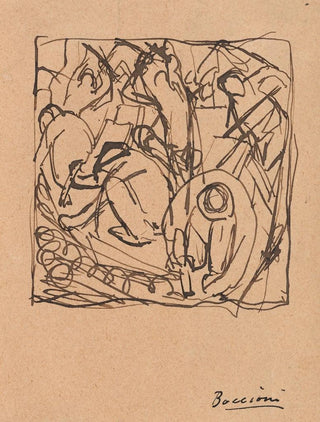Art print | Study of composition for Les Pavés de la rue - Umberto Boccioni


View from behind

Frame (optional)
In the vibrant world of modern art, the artwork "Study of Composition for Les Pavés de la rue" by Umberto Boccioni stands out for its ability to capture movement and energy from a time full of dynamism. This piece, which foreshadows the artist's futurist aspirations, evokes a dynamic vision of modernity, where speed and urbanity intertwine to create a new aesthetic. Viewing this art print, the viewer is immediately transported to the lively streets of the city, almost feeling the cobblestones underfoot and the breath of the wind accompanying this action-packed scene. It is an invitation to explore not only technique but also the emotion emanating from this iconic work.
Style and uniqueness of the work
The originality of "Study of Composition for Les Pavés de la rue" lies in how Boccioni transcends the artistic conventions of his time. The piece is characterized by dynamic shapes and flowing lines that evoke movement, creating an almost palpable sense of speed. The colors, often vivid and contrasting, reinforce this impression of energy, while the composition itself seems in perpetual change, as if the characters and objects are caught in a whirlwind of life. Architectural and human elements blend harmoniously, demonstrating the constant interaction between the individual and their urban environment. This unique style, which combines abstraction and figuration, makes Boccioni a pioneer in the exploration of modern art, paving the way for new perceptions of reality.
The artist and his influence
Umberto Boccioni, an emblematic figure of the futurist movement, managed to mark his era through his commitment to representing modernity in all its forms. Born in 1882 in Palermo, he quickly developed an interest in new technologies and social transformations that characterized the early 20th century. His artistic vision advocates the celebration of speed, machinery, and progress—themes that resonate deeply in "Study of Composition for Les Pavés de la rue." Boccioni is not merely a passive observer

Matte finish

View from behind

Frame (optional)
In the vibrant world of modern art, the artwork "Study of Composition for Les Pavés de la rue" by Umberto Boccioni stands out for its ability to capture movement and energy from a time full of dynamism. This piece, which foreshadows the artist's futurist aspirations, evokes a dynamic vision of modernity, where speed and urbanity intertwine to create a new aesthetic. Viewing this art print, the viewer is immediately transported to the lively streets of the city, almost feeling the cobblestones underfoot and the breath of the wind accompanying this action-packed scene. It is an invitation to explore not only technique but also the emotion emanating from this iconic work.
Style and uniqueness of the work
The originality of "Study of Composition for Les Pavés de la rue" lies in how Boccioni transcends the artistic conventions of his time. The piece is characterized by dynamic shapes and flowing lines that evoke movement, creating an almost palpable sense of speed. The colors, often vivid and contrasting, reinforce this impression of energy, while the composition itself seems in perpetual change, as if the characters and objects are caught in a whirlwind of life. Architectural and human elements blend harmoniously, demonstrating the constant interaction between the individual and their urban environment. This unique style, which combines abstraction and figuration, makes Boccioni a pioneer in the exploration of modern art, paving the way for new perceptions of reality.
The artist and his influence
Umberto Boccioni, an emblematic figure of the futurist movement, managed to mark his era through his commitment to representing modernity in all its forms. Born in 1882 in Palermo, he quickly developed an interest in new technologies and social transformations that characterized the early 20th century. His artistic vision advocates the celebration of speed, machinery, and progress—themes that resonate deeply in "Study of Composition for Les Pavés de la rue." Boccioni is not merely a passive observer






